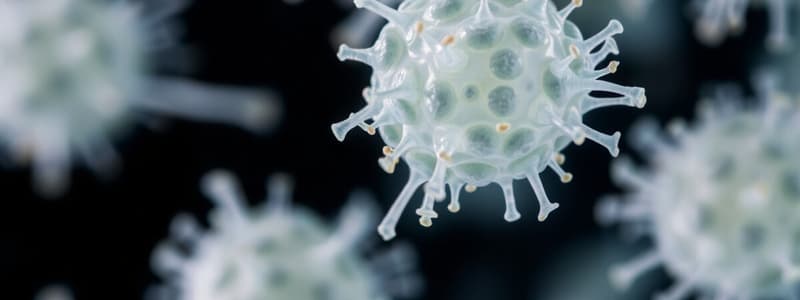Podcast
Questions and Answers
What is the primary purpose of using PCR in molecular identification?
What is the primary purpose of using PCR in molecular identification?
- To analyze protein structures.
- To identify species based on morphology.
- To amplify a short sequence of DNA. (correct)
- To amplify a short sequence of RNA.
Which type of ELISA allows for the capture of specific antigens?
Which type of ELISA allows for the capture of specific antigens?
- Competitive ELISA.
- Indirect ELISA.
- Sandwich ELISA. (correct)
- Double antibody ELISA.
What factor heavily influences the efficacy of PCR?
What factor heavily influences the efficacy of PCR?
- The concentration of the DNA sample.
- The temperature of the reaction.
- The selectivity of the primers used. (correct)
- The duration of the amplification process.
What does Multi Locus Sequence Typing (MLST) focus on amplifying?
What does Multi Locus Sequence Typing (MLST) focus on amplifying?
Which of the following is a major advantage of using MALDI TOF technology?
Which of the following is a major advantage of using MALDI TOF technology?
Which set of genes is typically targeted in the MLST of S. aureus?
Which set of genes is typically targeted in the MLST of S. aureus?
What is the desired combination of characteristics for an ideal diagnostic method?
What is the desired combination of characteristics for an ideal diagnostic method?
What information can MALDI TOF provide regarding bacterial species?
What information can MALDI TOF provide regarding bacterial species?
Which of the following best describes selective media in microbial identification?
Which of the following best describes selective media in microbial identification?
What is the primary purpose of distinguish strain typing within a species?
What is the primary purpose of distinguish strain typing within a species?
Which biochemical profiling technique typically does NOT require the cultivation of the microorganism?
Which biochemical profiling technique typically does NOT require the cultivation of the microorganism?
Why is colony morphology often considered an inaccurate method for identifying species?
Why is colony morphology often considered an inaccurate method for identifying species?
What is the role of Baird-Parker Agar in microbial identification?
What is the role of Baird-Parker Agar in microbial identification?
In what way does MacConkey Agar function as a selective and differential media?
In what way does MacConkey Agar function as a selective and differential media?
What information can be drawn from microscopic examination methods like Gram staining?
What information can be drawn from microscopic examination methods like Gram staining?
Molecular analysis in microbial identification includes which of the following techniques?
Molecular analysis in microbial identification includes which of the following techniques?
What characterizes the colonies of aureus in selective and differential media?
What characterizes the colonies of aureus in selective and differential media?
Which type of medium is Eosin Methylene Blue (EMB) agar selective for?
Which type of medium is Eosin Methylene Blue (EMB) agar selective for?
In Gram staining, what does the differentiation between Gram-positive and Gram-negative bacteria depend on?
In Gram staining, what does the differentiation between Gram-positive and Gram-negative bacteria depend on?
Which staining method is specifically used for detecting polysaccharides in living fungi?
Which staining method is specifically used for detecting polysaccharides in living fungi?
What does the Oxidase test detect in bacteria?
What does the Oxidase test detect in bacteria?
To visualize microorganisms using light microscopy, what is often necessary?
To visualize microorganisms using light microscopy, what is often necessary?
How is ATP quantified when determining bacterial numbers?
How is ATP quantified when determining bacterial numbers?
Which method is primarily used for genomic identification of microorganisms?
Which method is primarily used for genomic identification of microorganisms?
What is the primary purpose of the Miniaturised biochemical tests like API strips?
What is the primary purpose of the Miniaturised biochemical tests like API strips?
Which electron microscopy technique involves a high vacuum environment?
Which electron microscopy technique involves a high vacuum environment?
Flashcards
Microbial Identification
Microbial Identification
The process of identifying the specific type of microorganism, usually down to the species level.
Diagnostic Microbiology
Diagnostic Microbiology
A group of techniques used to determine the identity of an organism, usually a bacterium, based on its characteristics and behavior.
Typing
Typing
Distinguishing between different strains within the same species of microbe.
Culture-based methods
Culture-based methods
Signup and view all the flashcards
Selective media
Selective media
Signup and view all the flashcards
Microscopic examination
Microscopic examination
Signup and view all the flashcards
Biochemical profiling
Biochemical profiling
Signup and view all the flashcards
Molecular analysis
Molecular analysis
Signup and view all the flashcards
Differential Media
Differential Media
Signup and view all the flashcards
Gram-Positive Bacteria
Gram-Positive Bacteria
Signup and view all the flashcards
Gram-Negative Bacteria
Gram-Negative Bacteria
Signup and view all the flashcards
Gram Staining
Gram Staining
Signup and view all the flashcards
Electron Microscopy
Electron Microscopy
Signup and view all the flashcards
Light Microscopy
Light Microscopy
Signup and view all the flashcards
ATP (Adenosine Triphosphate)
ATP (Adenosine Triphosphate)
Signup and view all the flashcards
ELISA (Enzyme-Linked Immunosorbent Assay)
ELISA (Enzyme-Linked Immunosorbent Assay)
Signup and view all the flashcards
Sandwich ELISA
Sandwich ELISA
Signup and view all the flashcards
Direct ELISA
Direct ELISA
Signup and view all the flashcards
PCR (Polymerase Chain Reaction)
PCR (Polymerase Chain Reaction)
Signup and view all the flashcards
Primer Selectivity
Primer Selectivity
Signup and view all the flashcards
DNA Sequencing
DNA Sequencing
Signup and view all the flashcards
MALDI-TOF Mass Spectrometry
MALDI-TOF Mass Spectrometry
Signup and view all the flashcards
Immunological Assay
Immunological Assay
Signup and view all the flashcards
Accuracy in Diagnostics
Accuracy in Diagnostics
Signup and view all the flashcards
Study Notes
MPharm Programme: Microbial Identification
- The presentation is about microbial identification techniques for the MPharm program.
- The presenter is Dr. Callum Cooper, from the University of Sunderland.
Learning Objectives
- Describe various microbiological techniques for identifying bacterial contaminants.
- Compare and contrast classical and molecular identification methods.
- Highlight the advantages and limitations of each method.
- Link the lecture content to practical laboratory work.
- Determine if the contaminant is causing infection.
What is Diagnostic Microbiology?
- Identification of microorganisms, usually to the species level.
- Determining the differences between strains within a species.
- Antimicrobial susceptibility testing.
- Characterization of pathogens.
- Includes applications in veterinary microbiology, plant pathology, food microbiology, and pharmaceutical microbiology (identifying contaminants).
Microbial Identification: Methods
- Culture-based methods:
- Colony morphology analysis (shape, size, color, texture).
- Use of selective media (e.g., Mannitol salt agar, MacConkey agar) to isolate specific types of bacteria.
- Chromogenic media to identify particular microorganisms by the color change they generate.
- Microscopic examination:
- Gram staining to differentiate Gram-positive and Gram-negative bacteria.
- Electron microscopy for high-resolution images.
- Biochemical profiling:
- Tests to identify bacteria based on metabolic properties.
- Commercial kits (e.g., API strips, BD BBL Crystal) are used for fast testing.
- Molecular analysis:
- Genomic analysis (e.g., sequencing).
- Proteomic analysis.
- Immunological methods (e.g., ELISA).
Colony Morphology
- Microbes often live in complex communities, not individual species.
- Colony morphology alone is not reliable in identifying species.
- Isolating individual colonies and purifying them is needed for accurate identification.
Selective and Differential Media
- Selective media:
- Suppresses the growth of unwanted microorganisms.
- Allows chosen species to grow.
- Examples include MacConkey agar (for distinguishing Gram-negative bacteria), Sabouraud dextrose agar (for fungi), Baird-Parker agar (for staphylococci).
- Differential media:
- Enables the differentiation of bacterial species on the same medium.
- Examples include Mannitol salt agar (differentiating staphylococci based on fermentation of mannitol), Eosin Methylene Blue (EMB) agar (identifying lactose fermenters).
Microscopy
- Light microscopy and electron microscopy.
- Light microscopy types include dark field, transmission, and phase contrast.
- Electron microscopy types include transmission and scanning.
- Resolution and magnification capabilities of each type.
Light Microscopy - Sample Preparation
- Staining techniques to visualize microorganisms.
- Common stains for different types (bacteria, fungi, protozoa).
- Examples include Gram stain, Ziehl-Neelsen stain, Malachite Green stain.
- Periodic Acid-Schiff (PAS) stain detects polysaccharides.
Light Microscopy - Gram Staining
- Distinguishes bacteria based on cell wall composition (Gram-positive/Gram-negative).
- Detailed procedure for performing the gram stain.
Electron Microscopy
- Sample Preparation methods.
- Chemical fixation, dehydration, critical drying, metal coating etc.
Biochemical Profiling
- Identifying bacteria that are isolated in pure culture.
- Oxidase test (tests for cytochrome oxidase).
- Commercially available kits to analyze specific biochemical characteristics.
Molecular Identification
- Immunological Identification: ELISA (Enzyme-linked Immunosorbent Assay)
- Used for medical diagnostics (detecting HIV, TB, etc).
- Direct and Sandwich methods.
- Genomic Identification: PCR (polymerase chain reaction)
- Amplifies DNA sequences using primers.
- Used for identifying antibiotic resistance genes.
- DNA Sequencing- Identifying changes and whole genomes.
- Multilocus sequence typing methods to look for changes in key genes.
- Proteomic Identification (MALDI-TOF):
- Identifies bacteria based on ionized sample properties and compared with references in a database.
- Used to identify bacterial species from selective media.
- Can also provide information about resistance.
Biochemical Profiling: ATP Determination
- Adenosine Triphosphate (ATP) is a key energy source for bacteria.
- Amount of ATP correlated with the amount of light produced.
- ATP determination can count bacteria.
- Not effective for evaluating the contaminated sample itself.
Practice: Classical Non-Sterile Pharmaceutical Micro
- Typical protocol for isolating and identifying contaminants.
- Includes serial dilutions, streaking to purify, Gram staining, and biochemical assays for species identification.
Studying That Suits You
Use AI to generate personalized quizzes and flashcards to suit your learning preferences.
Related Documents
Description
This quiz focuses on microbial identification techniques relevant to the MPharm program. Participants will explore classical and molecular methods for identifying bacterial contaminants, their advantages, and limitations. Link theory to practical laboratory skills through diagnostic microbiology applications, including antimicrobial susceptibility testing.




